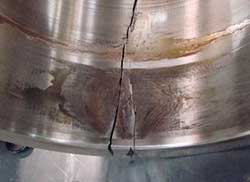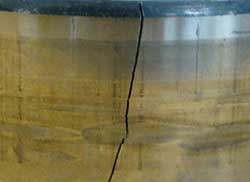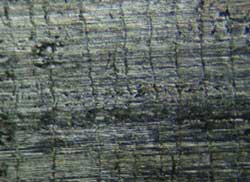MenuClose
Description
- Bearing rings may fracture either from fast fracture or fatigue
- Fast fracture usually results from rough handling such as striking the bearing with a hammer during installation or removal
- Fatigue fractures are typically secondary fractures resulting from stress concentrations generated at surface damage such as contact fatigue spalling
- Excessive hoop stress in a ring due to an incorrect fit can also result in a ring fracture
- Frictional heating generated from relative motion between the bearing and mating components can lead to rehardening and heat check cracks which can propagate and lead to ring fractures
Causes
-
Handling or installation damage
- Surface damage
- Incorrect fits or excessive drive up of tapered bore bearings
- Uneven ring support

Circumferential fracture of a cylindrical outer race. The fracture initiated at contact fatigue damage near one face of the bearing. The fatigue spalling and circumferential fracture resulted from uneven housing support.

Fatigue fracture of a cylindirical inner race through a lifting hole (arrow). The longer fracture was made during removal of the race. The fracture resulted from poor support of the race due to a low spot on the shaft.

Fatigue fracture of an inner race due to an insufficient shaft fit. Relative motion between the race and shaft resulted in heat check cracking on the bore of the inner race (image to the right) which led to the race fracturing at multiple locations.

Heat check cracking on bore of inner race.